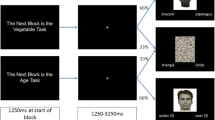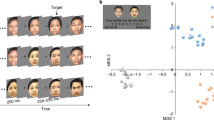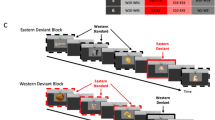Abstract
Functional magnetic resonance imaging (fMRI) was used to examine the nature of amygdala sensitivity to race. Both African-American and Caucasian-American individuals showed greater amygdala activity to African-American targets than to Caucasian-American targets, suggesting that race-related amygdala activity may result from cultural learning rather than from the novelty of other races. Additionally, verbal encoding of African-American targets produced significantly less amygdala activity than perceptual encoding of African-American targets.
This is a preview of subscription content, access via your institution
Access options
Subscribe to this journal
Receive 12 print issues and online access
$209.00 per year
only $17.42 per issue
Buy this article
- Purchase on Springer Link
- Instant access to full article PDF
Prices may be subject to local taxes which are calculated during checkout


Similar content being viewed by others
References
Zald, D.H. Brain Res. Brain Res. Rev. 41, 88–123 (2003).
Eberhardt, J.L. Am. Psychol. 60, 181–190 (2005).
Phelps, E.A. et al. J. Cogn. Neurosci. 12, 729–738 (2000).
Cunningham, W.A. et al. Psychol. Sci. 15, 806–813 (2004).
Macrae, C.N. & Bodenhausen, G.V. Annu. Rev. Psychol. 51, 93–120 (2000).
Hariri, A.R., Bookheimer, S.Y. & Mazziotta, J.C. Neuroreport 11, 43–48 (2000).
Wilson, T.D. & Schooler, J.W. J. Pers. Soc. Psychol. 60, 181–192 (1991).
Taylor, S.F., Phan, K.L., Decker, L.R. & Liberzon, I. Neuroimage 18, 650–659 (2003).
Haxby, J.V., Hoffman, E.A. & Gobbini, M.I. Trends Cogn. Sci. 4, 223–233 (2000).
Ghashghaei, H.T. & Barbas, H. Neuroscience 115, 1261–1279 (2002).
Rosenkranz, J.A. & Grace, A.A. J. Neurosci. 22, 324–337 (2002).
Aron, A.R., Robbins, T.W. & Poldrack, R.A. Trends Cogn. Sci. 8, 170–177 (2004).
Ochsner, K.N. et al. Neuroimage 23, 483–499 (2004).
Cunningham, W.A., Johnson, M.K., Gatenby, J.C., Gore, J.C. & Banaji, M.R. J. Pers. Soc. Psychol. 85, 639–649 (2003).
Perdue, C.W. et al. J. Pers. Soc. Psychol. 59, 475–486 (1990).
Acknowledgements
This work was supported by grants from National Science Foundation (BCS-0074562) and National Institute of Mental Health (MH66709) to M.D.L. The authors also wish to thank the Brain Mapping Medical Research Organization, Brain Mapping Support Foundation, Pierson-Lovelace Foundation, the Ahmanson Foundation, Tamkin Foundation, Jennifer Jones-Simon Foundation, Capital Group Companies Charitable Foundation, Robson Family, William M. and Linda R. Dietel Philanthropic Fund at the Northern Piedmont Community Foundation, Northstar Fund and the National Center for Research Resources (grants RR12169, RR13642 and RR08655) for their support.
Author information
Authors and Affiliations
Corresponding author
Ethics declarations
Competing interests
The authors declare no competing financial interests.
Supplementary information
Rights and permissions
About this article
Cite this article
Lieberman, M., Hariri, A., Jarcho, J. et al. An fMRI investigation of race-related amygdala activity in African-American and Caucasian-American individuals. Nat Neurosci 8, 720–722 (2005). https://doi.org/10.1038/nn1465
Received:
Accepted:
Published:
Issue Date:
DOI: https://doi.org/10.1038/nn1465
This article is cited by
-
The effects of experience of discrimination and acculturation during pregnancy on the developing offspring brain
Neuropsychopharmacology (2024)
-
Stronger brain activation for own baby but similar activation toward babies of own and different ethnicities in parents living in a multicultural environment
Scientific Reports (2022)
-
Neural responses in the pain matrix when observing pain of others are unaffected by testosterone administration in women
Experimental Brain Research (2020)
-
Neural dynamics of racial categorization predicts racial bias in face recognition and altruism
Nature Human Behaviour (2019)
-
How white and black bodies are perceived depends on what emotion is expressed
Scientific Reports (2017)



